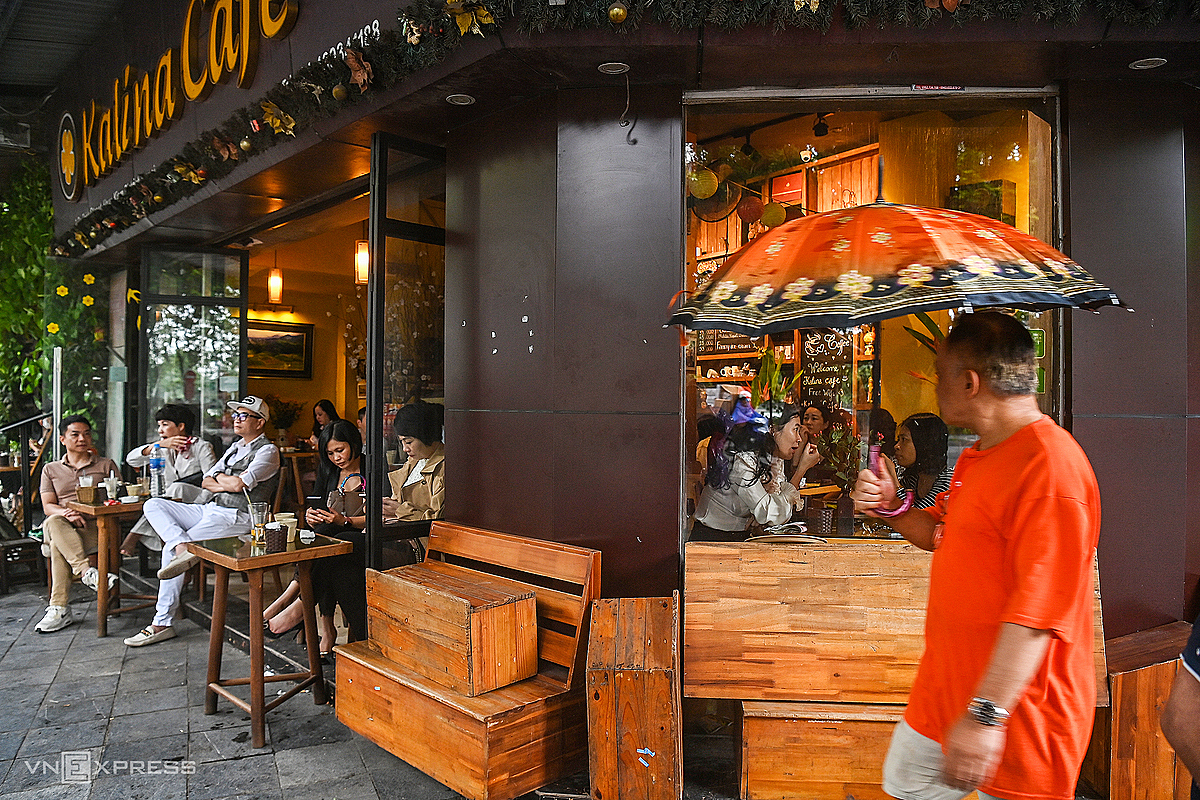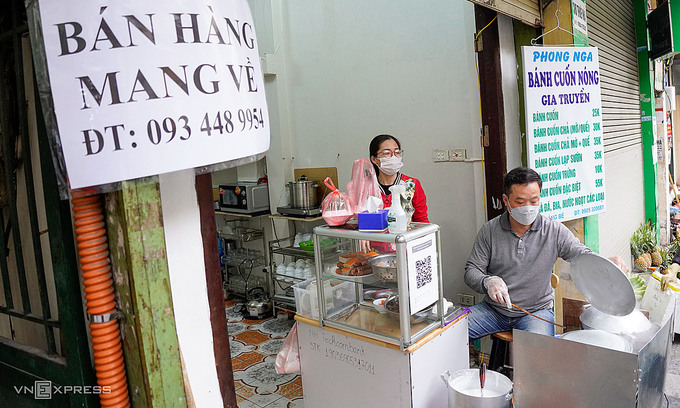Many residents of high risk Hanoi districts are traveling to safer areas to dine in, criticizing a ban on this service as an ineffective response to the Covid-19 pandemic.
Two days before her birthday, Lan Huong in Dong Da District was looking for a place to organize a party.
Familiar restaurants and cafes near Huong’s house had stopped on-site dining services, only allowing takeaways after the districts they were located in saw their coronavirus risk raised to a “high” level.
Ba Dinh, Hoan Kiem, Hoang Mai, Nam Tu Liem, and Tay Ho districts are only allowing eateries to serve takeaways and have limited large starting Sunday noon. Similar action has already been taken by Dong Da and Hai Ba Trung districts earlier this month.
Finally, on the evening of Dec. 27, Huong chose a restaurant on To Hieu Street in Cau Giay District, nearly 8 km from her home and more than 30 minutes away.
“It’s lucky that we can meet each other even if we have to travel that far,” Huong said.
 |
|
A coffee shop on Hanoi’s Ba Trieu Street, Oct. 14, 2021. Photo by VnExpress/Giang Huy |
Since the eight central districts in the capital city suspended dining in services, many people have chosen Huong’s path of traveling longer distances to “safer” places where they can still meet and enjoy a coffee or a meal at cafes and restaurants.
“I find that banning on-site dining in districts has no effect on pandemic prevention, it only causes trouble,” Huong said.
The ban is self-defeating, said Nguyen Viet Hung, Vice Chairman of the Hanoi Infection Control Society, explaining that it only facilitates contact tracing, not prevent residents from traveling between districts.
“The current ban based on administrative boundaries has no effect, because people can go to another district to eat or drink or gather at home, potentially spreading the risks.”
Thanh Nam of Hoang Mai District is a delivery worker and eats in random eateries. He usually has rice in Hai Ba Trung District, but since the Dec. 19 ban on on-site dining, he has to go to Hoan Kiem District for his daily meals.
After several days, when Hoan Kiem also banned on-site dining, Nam shifted to Ba Dinh District, which, in turn, ordered eateries to stop on-site dining services on Dec. 27.
Nam said shifting from one district to another for his meals was like being evacuated from one area after another.
He thought of buying food and sitting in a park or the sidewalk to eat, but was afraid he might be fined for not wearing a mask in public. Traveling home for food was not an option.
Minh Huong, who lives on Lang Street in Dong Da District sees herself as “one of the few luckiest people in Hanoi” as she lives between two districts. When the restaurant on Lang Street only sells takeouts, she only needs to walk about 200 meters to Nguyen Khang Street in Cau Giay District to enjoy on-site dining.
 |
|
An eatery in Hanoi displays a sign stating it only serves takeaways, Dec. 26, 2021. Photo by VnExpress/Vo Hai |
Hung also noted that while restricting non-essential services in eight districts can reduce the number of large gatherings, it also delivers many inconveniences for residents and inflicts economic losses.
Hoang Tuan Long, owner of a barbeque restaurant in Tay Ho District, said he has received less than 10 takeaway orders a day that over the past few days but still has to pay for electricity, water, rent and employees’ salaries as usual.
He said that if he asks employees not to come to work now, the risk of permanently losing them is very high because they will grow tired of the situation of going to the city to work for 1-2 months and then having to return.
“In the yellow (medium risk) and green (low) areas, it is still salvageable. But businesses in the orange (high) and red (very high) areas will suffer heavy losses,” he said.
In order for people to have a place to eat and food sellers to have a stable source of income, some shop owners suggested that the municipal authorities issue regulations to force restaurants to comply with Covid prevention measures like setting up partitions, operating at only 50 percent capacity, and at the same time, strictly dealing with those who violate the rules. There should be no ban on on-site dining, they argue.
Hung agreed. He said that the goal of anti-pandemic rules is to strengthen monitoring of compliance with preventive measures by residents and store owners.
He also noted that the capital city was one of the localities with the highest Covid-19 vaccination rates in the country.
Currently, the proportion of people aged 18 and over that have received at least one dose is 98.2 percent and the rate of people aged 50 and over receiving two doses is 95.1 percent.
Hanoi has recorded over 40,000 local infections in the fourth Covid wave that struck Vietnam in April.
On average, in the past week, Hanoi has recorded 1,700 infections a day. While the number of severe cases has increased, it has been reported that most of the deaths have been of people underlying diseases and those have not been vaccinated.
- Reduce Hair Loss with PURA D’OR Gold Label Shampoo
- Castor Oil Has Made a “Huge” Difference With Hair and Brow Growth
- Excessive hair loss in men: Signs of illness that cannot be subjective
- Dịch Vụ SEO Website ở Los Angeles, CA: đưa trang web doanh nghiệp bạn lên top Google
- Nails Salon Sierra Madre
 VnExpress News The News Gateway of Vietnam
VnExpress News The News Gateway of Vietnam
